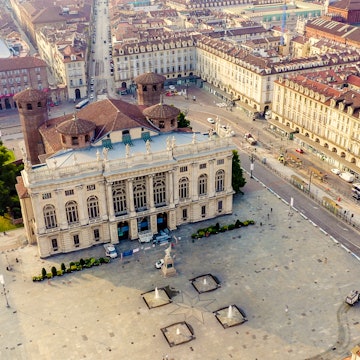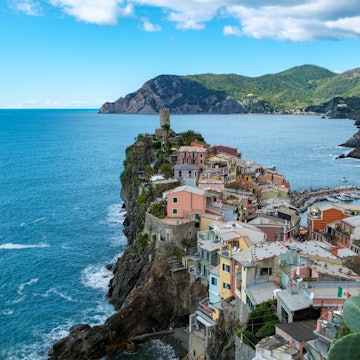

Lipari. Lolly66/Shutterstock
Some years ago I road-tripped through Sicily's idyllic north coast with three girlfriends from college. From Palermo to Cefalù and over the easternmost bump of the boot in Messina, we ringed around the island belting Mariah as we cruised south to Taormina, a posh resort town with Mt Etna as a backdrop. The trip was epic.
This past summer I remixed the route with a fresh itinerary and my 8-year-old son, Journey. We took the beloved Mediterranean basin by sea, sailing from Naples with stops in Salerno and Lipari, a precious pearl in the Tyrrhenian Sea and largest of the Aeolian Islands, where Journey leaped from a cliff into the deep blue waters, then swam 20m back to the boat with ease. I floated nearby on my back, encouraging him to glide. I returned to Taormina for ravioli, custom leather sandals and enchanting storybook scenes, continuing on to Catania and Syracuse, two ancient towns that breathe Sicily’s timeless beauty.
As a content executive and magazine editor who’s lived abroad and traveled to over 60 countries, both solo and coupled with friends, six cities in 6 days was a new undertaking for me and a child – my child, an articulate, epicurious, valiant traveler.
Journey and I enjoyed the seafaring experience immensely, but driving the coast is equally lovely. Here’s everything you need to know about venturing off the beaten path in Southern Italy and Sicily.


Trip length: 6 days; roughly 650km.
When to arrive and where to end: Drive from Naples to Messina, then hop on a ferry to Messina Marittima and head south to Syracuse. Or charter a small ship with Variety Cruises and take the Mediterranean in style (and sustainably).
Things to know: Many of Italy’s most appealing routes have been well traveled for centuries. And while some travelers caution against driving the coast – citing traffic, windy roads and car-free zones in inner cities – the country has no shortage of picturesque paths. Keep cash on hand for parking and tolls, and stay off your phone to avoid hefty fines or, much worse, having your International Driving Permit revoked. And heed flashing hazards, a lifesaving signal of attention needed ahead.
What to pack: If you’re going the boat route, attire on board is very casual, with shorts, sundresses and swimsuits the norm. Pack a few fun matching sets for full days exploring resort towns and cover-ups for religious and archeological sites. A versatile tote or backpack, comfortable shoes, plug adapters and a portable steamer are also nice to have.
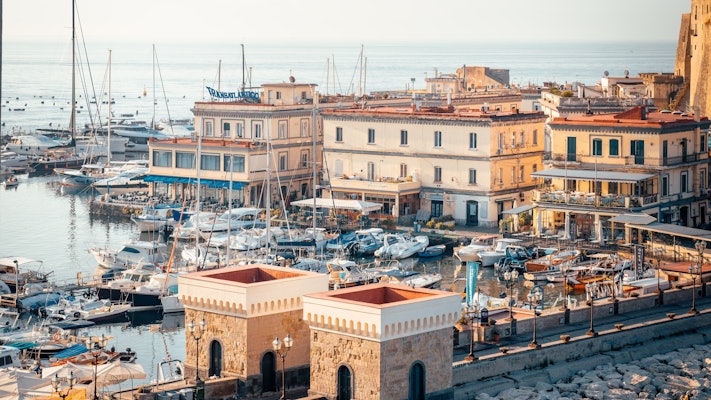



Day 1: Naples
Vibes: Naples is much more than a pit stop en route to Italy’s gorgeous coast. Opera, art, literature, film and Neapolitan pizza – a UNESCO-recognized culinary heritage – loom across this animated city. Of late, travelers are spending more time at Naples' top attractions, and subsequently, a gang of new restaurants, hotels and upgrades are emerging around town.
Do: See an opera at the Teatro di San Carlo; the acoustics in this unspoiled baroque theater, which opened in 1713, are exceptional. Browse for leather goods crafted by local artisans at Idem, a family-run accessories lab; each piece is handmade and customized with care. While getting around by metro, tour the underground's art installations in and around the stations on Lines 1 and 6 – this extraordinary public art project involving more than 100 artists and architects is open to all for the price of a train ticket. Wander about Spaccanapoli, a narrow street located in the heart of the historic center. Some of the city’s most revered religious sites are posted along this strip amid bakeries, fruit stands and locals zipping through on Vespas and bantering on balconies above.
Eat: From classic joints serving up marinara and margherita pies to next-level fine-dining spots that take the traditional slice to lofty heights, the first bite you should take in the birthplace of pizza is pizza. L’antica Pizzeria da Michele has been slinging humble pies since 1870. For a more modern menu and a quality glass of wine, hit Concettina ai Tre Santi in the Sanitá district.
Stay: Variety cabins are cozy, but there's limited space to move around. At first sight the tight quarters were alarming, but once we unpacked (we stored our luggage under the desk and clothing in the closet and drawers), things were just fine. Journey and I shared a bright room on the main deck with two twin beds and a double window. Ample lounge space throughout the ship and an elegant glass-enclosed dining room made up for what the cabin lacked in elbow room.
The journey: We sailed overnight and woke up the next morning in Salerno. If you’re driving (69km), spend the night at the Romeo hotel in Naples, a contemporary property designed by Japanese architect Kenzo Tange, and hit the road when you rise. There are some great stops along the way: Galleria Borbonica, the town of Capua and the Giardini di Augusto in Capri. The train is also an option. Daily direct routes depart Naples every 20 minutes.
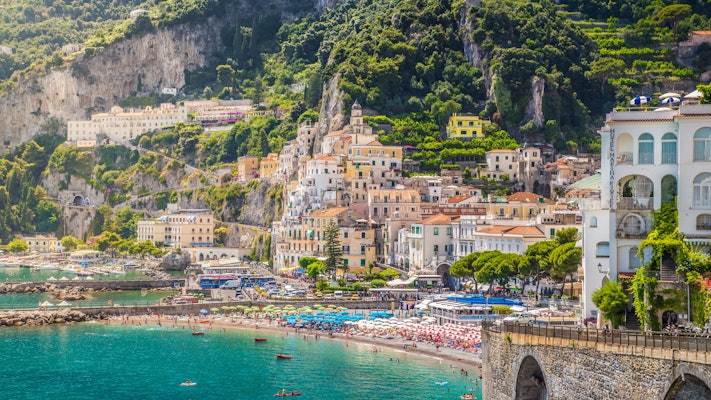

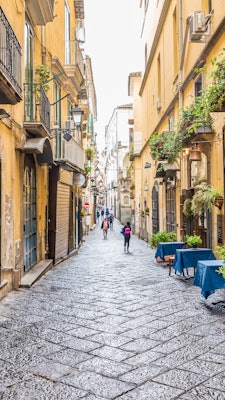
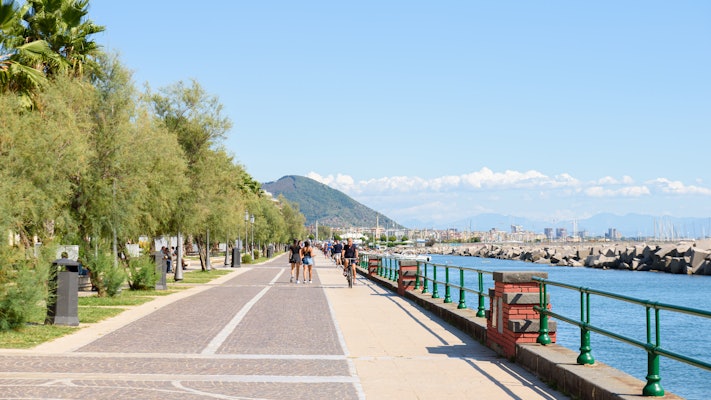
Day 2: Salerno
Vibes: This often overlooked port city is the gateway to the Amalfi Coast. But with a new seafront promenade and a well-preserved historic center boasting medieval blocks and cobblestone corners, Salerno is worth getting to know.
Do: Tour the Chiesa di San Giorgio, the most breathtaking baroque church in town. The elaborate olive green doors at the sanctuary’s entrance deserve to be framed. A short walk uphill leads to the Duomo, an ornate cathedral dating back to 1084. (Its subterranean chamber is one of the most beautiful works of art I’ve ever seen.) Mingle with locals on Spiaggia Santa Teresa, a busy, urban beach that calls the whole family to play. Vincento, a stocky, dimple-faced 5 year-old with a single ear piercing and a mischievous grin, kept Journey and I entertained until sunset.
Eat: Grab a corner table at L’Unico, a treasure hiding in plain sight on the back blocks of Salerno. The seafood is fresh, and the atmosphere and staff are inviting. Order the spaghetti a gamberi rossi, made with prized red Mediterranean prawns, fresh tomatoes, garlic, olive oil and a splash of white wine.
Stay: Salerno is yet to be noticed by international tourism, which means its hotels aren’t as glamorous as those on the neighboring Amalfi Coast. Trade five-star amenities for old world charm at Donna Giulia, Luxury House. The private residence is located on the second floor of Palazzo Santoro, with six spacious guest rooms decorated with classical pottery and artwork.
The journey: Rise rested and ready to continue your adventure down the coast. Drive south from Salerno to Villa San Giovanni (Messina), return your one-way rental, then catch the ferry to Messina Marittima. From the port, hop in a rideshare for about €5 per person, or secure your own wheels and drive 50km south to Taormina. Or catch the train; the fastest route is 5 hours so nap, read and admire sweeping views along the way.

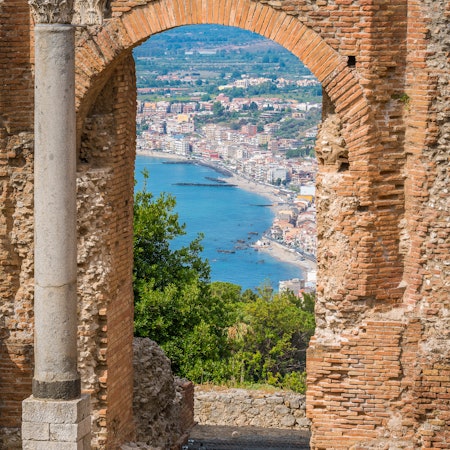
Day 3 and 4: Taormina
Vibes: The views from Taormina have inspired visitors for centuries. When you’re done gawking over the mountains to the Ionian Sea, hit the cobblestone streets and get under the skin of this medieval town.
Do: Take a scenic cable car ride from the coast to the historic hilltop town. Stroll Corso Umberto, a vibrant strip with shops, cafes and a shop with creamy gelato. Visit the Teatro Greco for iconic ruins and spectacular sunset views. Tour Savoca, a lesser-known Sicilian village that served as the backdrop for The Godfather.
Eat: Known for its authentic Sicilian cuisine and sweet location, Osteria da Rita is a popular pick for lunch and dinner. The family-run trattoria sits on one of the most vibrant streets in Taormina. Secure a table outside to people watch and nibble on bruschetta and a chilled glass of wine before the culinary stars arrive: impepata di cozze (mussels steamed in tomato broth) and raviolini ripieni con ricotta e spinaci (ravioli stuffed with ricotta and spinach, topped with fresh cherry tomatoes, basil and garlic).
Stay: A short drive down the hill in Giardini Naxos is Villa Sant’Andrea, your beachside base for the next two nights. Designed by an aristocratic family in 1919, this elegant retreat is the perfect place to recharge after full days exploring bustling Taormina. Lido Villeggiatura, the hotel’s private beach club, encourages relaxation in its private cabanas and sun beds.
The journey: Next stop, Catania, home to Via dei Crociferi, one of the most beautiful baroque streets in Italy. The journey from Taormina is fairly simple. Head 55km south on the A18 and follow the signs for Catania Centro. Stop at Mt Etna along the way for panoramic views of Europe’s largest and most active volcano. If you’re training it, hop on at Taormina Giardini and hop off an hour later in Catania Centrale.




Day 5: Catania
Vibes: Discovered by the Greeks in the 8th century BCE and later ruled by Romans, Arabs and Spaniards, Catania tells its story of repeated rebuilding through architecture. Today, the palpable energy and scruff instantly pull you in.
Do: Poke your head into the Cattedrale di Sant'Agata. Shop for local and artisanal textiles and jewelry at Colori del Sole. Venture to Via Gisira (aka Umbrella Street) to experience a vibrant art installation with hundreds of umbrellas, forming a kaleidoscopic canopy you can’t help but photograph. Then head to the post office with a stack of postcards and a few moments to spare for a sparky glimpse into everyday Sicilian life.
Eat: From Michelin-starred Sapio and popular Maccaruni to fast-casual Fud Bottega Sicula, there’s no shortage of quality bites across Catania. But La Pescheria, the open-air fish market behind Piazza Duomo is the experience your palette’s been waiting for. Open weekdays and Saturdays from 7:30am to 2pm, rows of aromatic stalls grilling squid, shucking oysters and slinging the Mediterranean's freshest catch are eager to serve you.
Stay: Bastiò Private Suites, a boutique hotel in the center of Catania, is a short walk from Piazza del Duomo. The rooms are spacious and bright, with modern furnishings and amenities. Meditate on the tree-lined sun terrace, savor a traditional Sicilian meal at the on-site restaurant, then head over to the bar for a craft cocktail inspired by the region’s citrus fruits and local liqueurs.
The journey: The quickest and most efficient way to get from Catania to Syracuse is to drive south for roughly an hour (61km) on the RA15 autostrada (toll highway). Pull over in Aci Trezza, a fishing village known for its distinctive volcanic sea stacks. The train is also a nice option if Syracuse is your last leg and you want to stretch out and chill.
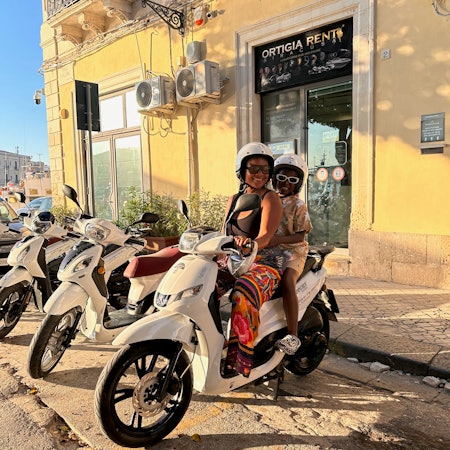

Day 6: Syracuse
Vibes: In its prime, Syracuse was the largest city in the ancient world, bigger than Athens and Corinth. The city of today, in the southeast corner of Sicily, thrives as a hub of culture and style.
Do: Book a boat excursion with Ortigia Mare and sail around the island for caves, coves and secluded swim stops. Hit the beach at Spiaggia di Cala Rossa, an intimate pebble bay with crystal-clear waters and friendly, sun-kissed locals. Rent a Vespa and get lost in the alleys of Ortigia, a historic maze originally designed as a defense against invaders. Visit the Duomo, the baroque masterpiece built on an ancient Greek temple.
Eat: A Putia di Giugiò is a homey dining spot putting a modern spin on traditional Sicilian cuisine with pretty pasta and seafood plates. When we visited, Journey was craving grilled squid, which wasn’t on the menu, so he confidently requested it. When he did, the owner cupped his chin, kissed his forehead and, 20 minutes later, emerged from the kitchen with charred octopus spiced with sea salt, black pepper, oregano, lime and olive oil. I tried a savory rigatoni dish with fresh fish, olives and cherry red tomatoes. Deliziosa! Split a tiramisu (a layered dessert with cookies, coffee, whipped cream, mascarpone, and cocoa powder), then walk over to Mangano Sapuri Siciliano for a decadent cannoli to go.
Webb traveled to Italy at the invitation of Variety Cruises. Lonely Planet contributors do not accept freebies in exchange for positive coverage.









